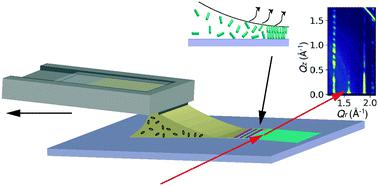当前位置:
X-MOL 学术
›
Mol. Syst. Des. Eng.
›
论文详情
Our official English website, www.x-mol.net, welcomes your
feedback! (Note: you will need to create a separate account there.)
Dynamic processes in transient phases during self-assembly of organic semiconductor thin films
Molecular Systems Design & Engineering ( IF 3.2 ) Pub Date : 2021-10-05 , DOI: 10.1039/d1me00078k Jing Wan 1 , Yang Li 1 , Jared Benson 1 , Richards Miller 1 , Mikhail Zhernenkov 2 , Guillaume Freychet 2 , Randall L. Headrick 1
Molecular Systems Design & Engineering ( IF 3.2 ) Pub Date : 2021-10-05 , DOI: 10.1039/d1me00078k Jing Wan 1 , Yang Li 1 , Jared Benson 1 , Richards Miller 1 , Mikhail Zhernenkov 2 , Guillaume Freychet 2 , Randall L. Headrick 1
Affiliation

|
Understanding and manipulating crystallization processes has been an important challenge for solution-processed organic thin films, both for fundamental studies and for fabricating thin films with near-intrinsic charge transport properties. We report an in situ X-ray scattering study of the crystallization of 2-decyl-7-phenyl-[1]benzothieno[3,2-b][1]benzothiophene (Ph-BTBT-C10) during its deposition from solution. At temperatures modestly below the smectic-E/crystalline phase boundary, the crystallization goes through a transient liquid crystal state before reaching the final stable crystalline phase. Significant dynamics occur in the first few seconds of the transition, which are observed through fluctuations in the X-ray scattering intensity, and are correlated with the time interval that the transient thin film coexists with the evaporating solvent. The transition to the stable crystalline phase takes minutes or even hours under these conditions, which may be a result of the asymmetry of the molecule. Transient phases are of potential interest for applications, since they can act as a route to self-assembly of organic thin films. However, our observations show that the long-lived monolayer-stacked intermediate state does not act as a template for the bilayer-stacked crystalline phase. Rather, the grain structure is replaced through nucleation, where the nucleation free-energy barrier is related to a potential barrier that prevents molecules to flip their long axis by 180°.
中文翻译:

有机半导体薄膜自组装过程中瞬态阶段的动态过程
理解和操纵结晶过程一直是溶液处理有机薄膜的重要挑战,无论是基础研究还是制造具有近本征电荷传输特性的薄膜。我们报告的原位2-癸基-7-苯基- [1]苯并噻吩并[3,2-的结晶的X射线散射研究b ] [1]苯并噻吩(PH-BTBT-C 10) 在其从溶液中沉积的过程中。在略低于近晶-E/结晶相边界的温度下,结晶在达到最终稳定的结晶相之前会经历一个瞬态的液晶状态。显着的动态发生在转变的前几秒,这是通过 X 射线散射强度的波动观察到的,并且与瞬态薄膜与蒸发溶剂共存的时间间隔相关。在这些条件下,向稳定结晶相的转变需要几分钟甚至几小时,这可能是分子不对称的结果。瞬态相具有潜在的应用价值,因为它们可以作为有机薄膜自组装的途径。然而,我们的观察表明,长寿命的单层堆叠中间态不能作为双层堆叠结晶相的模板。相反,晶粒结构通过成核取代,其中成核自由能垒与防止分子将其长轴翻转 180° 的势垒有关。
更新日期:2021-11-24
中文翻译:

有机半导体薄膜自组装过程中瞬态阶段的动态过程
理解和操纵结晶过程一直是溶液处理有机薄膜的重要挑战,无论是基础研究还是制造具有近本征电荷传输特性的薄膜。我们报告的原位2-癸基-7-苯基- [1]苯并噻吩并[3,2-的结晶的X射线散射研究b ] [1]苯并噻吩(PH-BTBT-C 10) 在其从溶液中沉积的过程中。在略低于近晶-E/结晶相边界的温度下,结晶在达到最终稳定的结晶相之前会经历一个瞬态的液晶状态。显着的动态发生在转变的前几秒,这是通过 X 射线散射强度的波动观察到的,并且与瞬态薄膜与蒸发溶剂共存的时间间隔相关。在这些条件下,向稳定结晶相的转变需要几分钟甚至几小时,这可能是分子不对称的结果。瞬态相具有潜在的应用价值,因为它们可以作为有机薄膜自组装的途径。然而,我们的观察表明,长寿命的单层堆叠中间态不能作为双层堆叠结晶相的模板。相反,晶粒结构通过成核取代,其中成核自由能垒与防止分子将其长轴翻转 180° 的势垒有关。











































 京公网安备 11010802027423号
京公网安备 11010802027423号